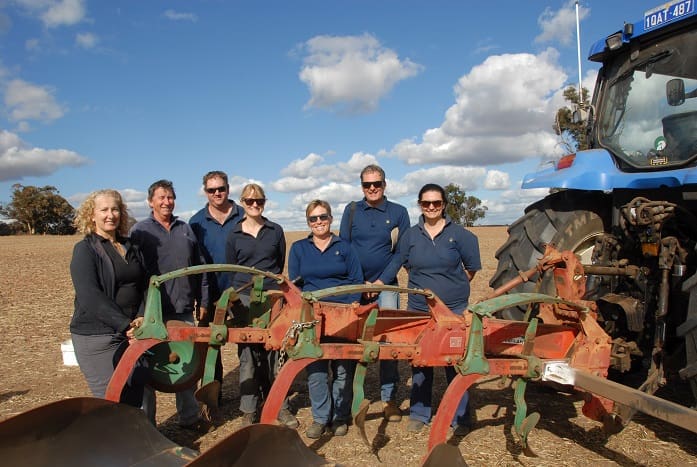
DPIRD officers Christine Zaicou-Kunesch, Steve Cosh, Chad Reynolds, Carla Wilkinson, Dr Sarah Collins, Dr Steve Davies and Jo Walker are working on a project co- funded by GRDC, to increase and sustain the benefits of soil amelioration on crop production.
A SERIES of field experiments has been established across Western Australia’s grainbelt in recent months as part of a new project that aims to increase the benefits and profitability generated by soil amelioration by an estimated $20-40 per hectare per year.
The $15.48 million, five-year project is part of a suite of soil research investments announced earlier this year by the Department of Primary Industries and Regional Development and the Grains Research and Development Corporation.
The project will build on more than a decade of research by the partners, which has confirmed significant yield responses from one off deep tillage and the incorporation of soil amendments to overcome a range of production constraints on sand plain soils.
It will draw on the expertise of cross-functional team of scientists, including agronomists, plant pathologists and soil specialists.
Project leader, research officer Steve Davies, said the project would develop a new farming systems package and agronomic options to maintain the benefits of soil amelioration and assist growers to adopt proven techniques that overcome a range of soil and agronomic constraints.
Dr Davies said the research would examine the transition phase immediately following soil amelioration, as well as the post-transition phase in subsequent seasons to capitalise on the improved yield potential of wheat, barley, canola and lupins.
“The timing of amelioration, rotations and species choice immediately following soil amelioration, during the transition phase, will be crucial to sustaining crop water use efficiency and nutrient use,” he said.
“Shifting the timing of amelioration to winter or spring and then sowing a late season summer crop could reduce the risk of wind erosion and aid crop establishment the following season.
“This strategy may open up the opportunity to sow a high value break crop, like canola, in the early transition years, when the yield response can be at its highest.”
Dr Davies said refining crop rotation and species choice may help to consolidate the benefits of soil amelioration in the post-amelioration phase in subsequent years.
“This includes sustaining the suppression of weeds, pests and diseases or improved soil fertility or aiding subsoil root access through regenerated root channels – all of which could increase subsoil water and nutrient access to enhance crop potential,” he said.
The crop establishment component of the research will investigate the effect of amelioration and seedbed preparation on herbicide activity and plant establishment of lupin, wheat and canola crops.
“The research seeks to develop new approaches to seedbed preparation, herbicide use, seeding approaches and furrow formation to optimise crop establishment and minimise the risk of herbicide damage to crops sown into ameliorated soils,” Dr Davies said.
Field trials have been established in recent months at Darkan, Yerecoin, and Mingenew to assess amelioration timing and impacts on biotic constraints and amelioration timing.
The experiments have been established with support from growers and local grower groups, including the Compass Agricultural Alliance and Mingenew Irwin Group.
More sites across the grainbelt will be added to the project in subsequent seasons.
Three case studies of early adopters are also being incorporated into the research to compare crop responses in ameliorated paddocks over time and capture the learnings of growers who have experience in soil amelioration.
Dr Davies said the ultimate aim of the project was to assist at least a quarter of WA growers with ameliorated soils to adopt the new farming systems and agronomy packages with confidence, backed by sound scientific evidence.
“There are about 5.8 million hectares of land suitable for amelioration across the medium to high rainfall zones of the WA grainbelt, of which about 250,000ha have already been treated,” he said.
“Although this area is expanding, many growers with these soils have yet to reap the full long-term value from soil amelioration.
“This project aims to provide the knowledge and experience so growers can make informed decisions about how best to boost their crop returns from investing in deep tillage and amendment options that best suit their operation.”
Source: DPIRD, GRDC

HAVE YOUR SAY